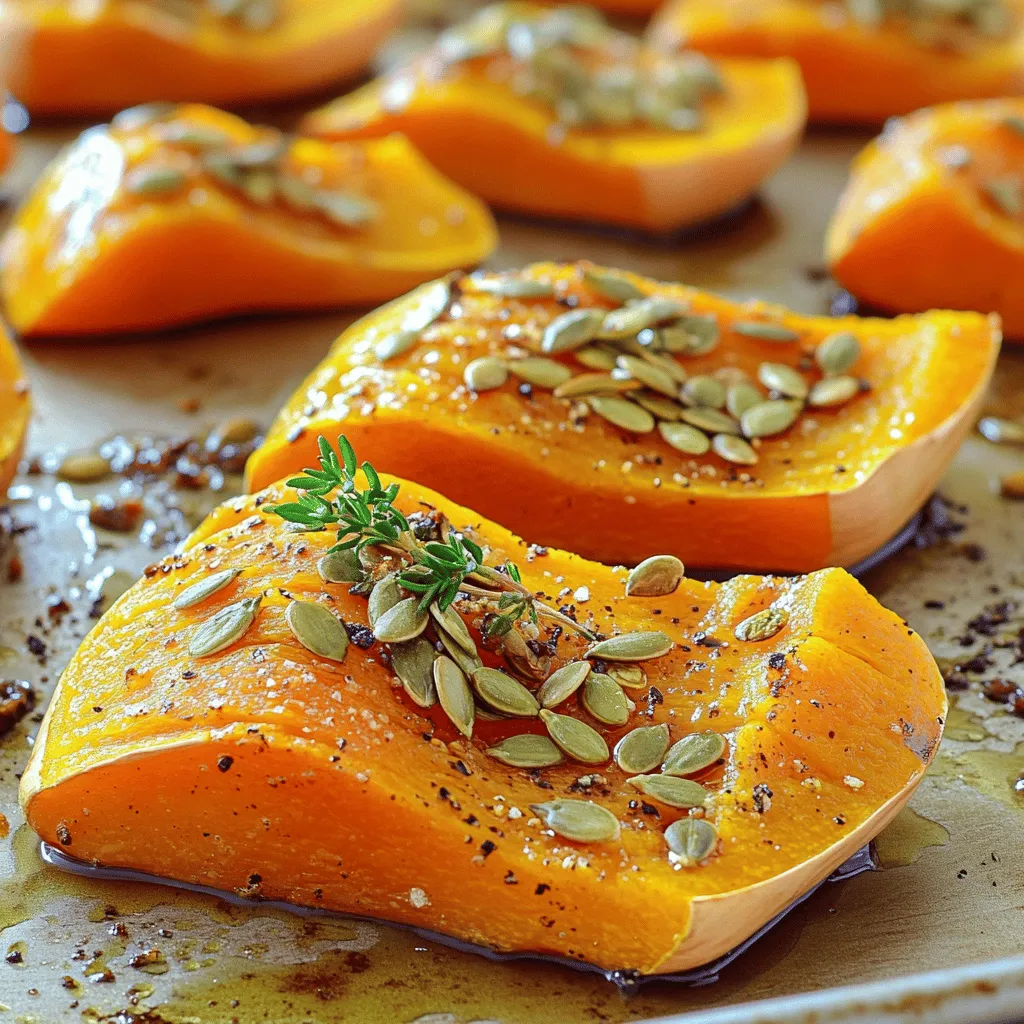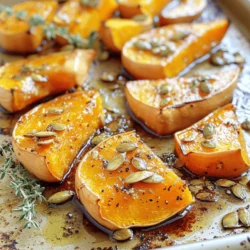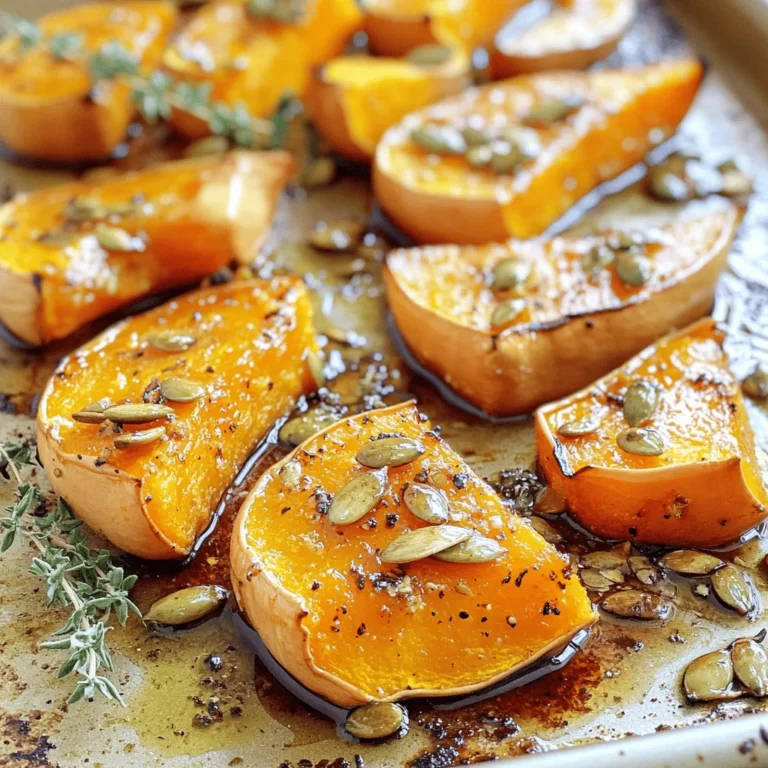If you’re looking for a warming side dish that bursts with flavor, look no further! Maple roasted butternut squash combines sweet maple syrup with the earthy taste of butternut squash. This dish is easy to make and adds a delightful touch to any meal. Join me as we explore simple steps to create this savory dish, perfect for gatherings or cozy dinners at home. Let’s dive in!
Ingredients
Main Ingredients
- 1 medium butternut squash, peeled, seeded, and cubed
- 3 tablespoons pure maple syrup
- 2 tablespoons olive oil
- 1 teaspoon cinnamon
- 1/2 teaspoon nutmeg
- Salt and pepper to taste
Optional Garnishes
- 2 tablespoons pumpkin seeds
- Fresh thyme leaves
When making maple roasted butternut squash, you need simple, fresh ingredients. The star is the butternut squash. Choose one that feels heavy for its size. The skin should be smooth and free of blemishes.
Maple syrup adds sweetness and depth. Use pure maple syrup for the best taste. Olive oil helps the squash roast nicely. It also brings flavor. Cinnamon and nutmeg add warmth. Don’t forget salt and pepper; they enhance all the flavors.
For a crunchy finish, consider pumpkin seeds. They add texture and a nutty flavor. Fresh thyme leaves can brighten the dish. These garnishes are optional, but they make your dish look and taste even better.
Step-by-Step Instructions
Preparation Steps
- Preheat the oven to 400°F (200°C).
- In a large bowl, combine the cubed butternut squash, maple syrup, olive oil, cinnamon, nutmeg, and salt. Toss well to coat the squash evenly with the seasoning.
Starting with the right temperature is key. Preheating the oven helps the squash cook evenly. Mixing the flavors in a bowl makes the squash tasty. The maple syrup adds a sweet touch, while the spices bring warmth.
Roasting Instructions
- Spread the seasoned squash on a baking sheet in a single layer.
- Roast for about 25-30 minutes, stirring halfway through. Check for tenderness.
When you spread the squash out, it cooks better. Stirring during roasting helps it brown nicely. You want it to be golden and soft. If you want a crunch, add pumpkin seeds in the last five minutes.
Serving Suggestions
- Let the squash cool slightly before serving.
- Garnish with fresh thyme if desired.
Cooling a bit makes it easier to handle. Fresh thyme adds a nice touch and flavor. You can serve it as a side dish or on its own. This maple roasted butternut squash is a real treat!
Tips & Tricks
Selecting the Right Squash
When choosing butternut squash, look for one that feels heavy. The skin should be smooth and free of cracks. A good squash has a tan color and a firm stem. If it is too soft, it may be overripe. To peel and cube, use a sharp knife. Cut off both ends first. Then, slice the squash in half lengthwise. Scoop out the seeds with a spoon. Finally, peel the skin with a vegetable peeler and cube the flesh.
Enhancing Flavor
To add depth to your maple roasted butternut squash, try extra spices. Paprika or garlic powder can bring a nice punch. For a touch of heat, add a pinch of cayenne. You can also adjust the sweetness. If you like it sweeter, add more maple syrup. For a more savory note, reduce the syrup slightly. Always taste the mix before roasting to find your perfect balance.
Roasting Tips
Even cooking is key for great results. Spread the squash in a single layer on the baking sheet. This helps each piece cook evenly. Stir halfway through to ensure all sides get nice and golden. I also recommend using parchment paper. It makes cleanup easy and prevents sticking. Plus, it helps the squash roast rather than steam.

Variations
Flavor Combinations
You can play with flavors when making maple roasted butternut squash. One fun mix is maple rosemary butternut squash. Just add fresh rosemary to the squash before roasting. This herb gives a nice earthy taste that goes well with the sweet maple.
Another great option is mixing sweet potatoes with butternut squash. The sweet potato adds creaminess and a richer flavor. You can roast them together in the same pan. Just make sure to cut them into even pieces so they cook well.
Dietary Adjustments
If you want a vegan version, skip the honey and stick with maple syrup. This recipe is already vegan-friendly, so it’s easy to adjust. You can also swap out olive oil for coconut oil if you prefer.
For those with nut allergies, just leave out any nuts or seeds. The dish will still taste great without them. You can replace pumpkin seeds with sunflower seeds for a safe crunch.
Serving Styles
Maple roasted butternut squash works well in many dishes. One idea is to make a salad. Toss the roasted squash with greens, nuts, and a simple dressing. This gives a warm and filling salad that is perfect for lunch or dinner.
You can also serve it as a side dish or even a main course. Pair the squash with grains like quinoa or rice for a hearty meal. It’s a great way to enjoy this tasty dish in different ways.
Storage Info
Storing Leftovers
After you enjoy your maple roasted butternut squash, store any leftovers in an airtight container. Refrigerate them within two hours of cooking. This helps keep the squash fresh. It can stay in the fridge for up to four days. If you want to save it for longer, consider freezing.
To freeze, let the squash cool completely. Then, spread it on a baking sheet in a single layer. Once frozen, transfer the squash to a freezer-safe bag. It can last up to three months in the freezer. Just label the bag with the date to keep track.
Reheating Methods
You can reheat your maple roasted butternut squash in the oven or microwave. For the best taste and texture, use the oven. Preheat it to 350°F (175°C). Spread the squash on a baking sheet and heat for about 10-15 minutes or until warm. This method keeps the squash crispy.
If you’re short on time, use the microwave. Place the squash in a microwave-safe dish. Cover it loosely with a lid or plastic wrap. Heat on high for 1-2 minutes, checking often. This method is quicker but may make the squash a bit softer. No matter how you reheat it, your squash will still taste delicious!
FAQs
How do you know when butternut squash is done?
You can tell butternut squash is done when it turns golden brown and feels soft. Use a fork to poke it. If it goes in easily, your squash is ready. Look for these signs:
- Golden brown color
- Tender texture
- Sweet aroma
These signs mean you achieved perfect roasting.
Can I use a different sweetener?
Yes, you can swap maple syrup for other sweeteners. Here are some great options:
- Honey: Adds a floral note.
- Agave nectar: A lighter flavor.
- Brown sugar: Gives a richer sweetness.
- Coconut sugar: Adds a caramel-like taste.
Each sweetener changes the taste slightly. Choose one that you enjoy!
What are some good side dishes with maple roasted butternut squash?
Maple roasted butternut squash pairs well with many dishes. Here are some ideas:
- Quinoa salad: Adds protein and texture.
- Roasted Brussels sprouts: Offers a nice crunch.
- Grilled chicken: Complements the sweetness.
- Spinach salad: Brings a fresh, green element.
These sides create a balanced meal.
In this blog post, we explored how to make flavorful maple roasted butternut squash. I shared the best ingredients, from fresh squash to spices. We went through easy steps for prep and roasting. I included tips for selecting squash and enhancing flavor. Don’t forget the variations and storage advice. You can enjoy this dish in many ways. I hope you find joy in cooking this tasty recipe for yourself or others!


